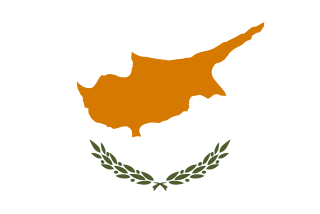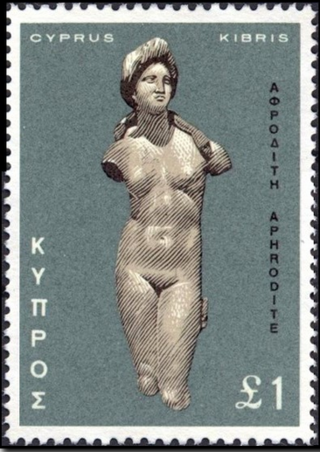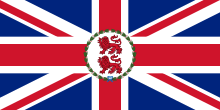
Cyprus, officially the Republic of Cyprus, is an island country located in the eastern Mediterranean Sea. It is geographically in Western Asia, but its cultural ties and geopolitics are overwhelmingly Southeastern European. Cyprus is the third-largest and third-most populous island in the Mediterranean. It is located north of Egypt, east of Greece, south of Turkey, and west of Lebanon and Syria. Its capital and largest city is Nicosia. The northeast portion of the island is de facto governed by the self-declared Turkish Republic of Northern Cyprus, a claim not recognised by the international community.

Human habitation of Cyprus dates back to the Paleolithic era. Cyprus's geographic position has caused Cyprus to be influenced by differing Eastern Mediterranean civilisations over the millennia.

Enosis is the movement of various Greek communities that live outside Greece for incorporation of the regions that they inhabit into the Greek state. The idea is related to the Megali Idea, an irredentist concept of a Greek state that dominated Greek politics following the creation of modern Greece in 1830. The Megali Idea called for the annexation of all ethnic Greek lands, parts of which had participated in the Greek War of Independence in the 1820s but were unsuccessful and so remained under foreign rule.

The Middle East, also known as the Near East, is home to one of the Cradles of Civilization and has seen many of the world's oldest cultures and civilizations. The region's history started from the earliest human settlements and continues through several major pre- and post-Islamic Empires to today's nation-states of the Middle East.
The Cyprus Convention of 4 June 1878 was a secret agreement reached between Great Britain and the Ottoman Empire which granted administrative control of Cyprus to Britain, in exchange for its support of the Ottomans during the Congress of Berlin. Provisions in the Convention retained Ottoman rights over the territory of Cyprus.
Turkish Cypriots or Cypriot Turks are ethnic Turks originating from Cyprus. Following the Ottoman conquest of the island in 1571, about 30,000 Turkish settlers were given land once they arrived in Cyprus. Additionally, many of the island's local Christians converted to Islam during the early years of Ottoman rule. Nonetheless, the influx of mainly Muslim settlers to Cyprus continued intermittently until the end of the Ottoman period. Today, while Northern Cyprus is home to a significant part of the Turkish Cypriot population, the majority of Turkish Cypriots live abroad, forming the Turkish Cypriot diaspora. This diaspora came into existence after the Ottoman Empire transferred the control of the island to the British Empire, as many Turkish Cypriots emigrated primarily to Turkey and the United Kingdom for political and economic reasons.
Greek Cypriots are the ethnic Greek population of Cyprus, forming the island's largest ethnolinguistic community. According to the 2011 census, 659,115 respondents recorded their ethnicity as Greek, forming almost 99% of the 667,398 Cypriot citizens and over 78% of the 840,407 total residents of the area controlled by the Republic of Cyprus. These figures do not include the 29,321 citizens of Greece residing in Cyprus, ethnic Greeks recorded as citizens of other countries, or the population of Northern Cyprus.

The Eyalet of Cyprus was an eyalet (province) of the Ottoman Empire made up of the island of Cyprus, which was annexed into the Empire in 1571. The Ottomans changed the way they administered Cyprus multiple times. It was a sanjak (sub-province) of the Eyalet of the Archipelago from 1670 to 1703, and again from 1784 onwards; a fief of the Grand Vizier ; and again an eyalet for the short period from 1745 to 1748.

This article is about the history of Cyprus from 1878 to the present.

British Turks or Turks in the United Kingdom are Turkish people who have immigrated to the United Kingdom. However, the term may also refer to British-born persons who have Turkish parents or who have a Turkish ancestral background.

Mehmed Kâmil Pasha, also spelled as Kiamil Pasha, was an Ottoman statesman and liberal politician of Turkish Cypriot origin in the late-19th-century and early-20th-century. He was the Grand Vizier of the Empire during four different periods.

The history of the Jews in Cyprus dates back at least to the 2nd century BC, when a considerable number of Jews in Cyprus was first recorded. The Jews had close relationships with many of the other religious groups on the island and were seen favourably by the island's Roman rulers. During the war over the city of Ptolemais between Alexander Jannaeus and King Lathyros, many Jews remained committed to King Lathyros and were subsequently killed.

The Cyprus Emergency, also known as the Greek Cypriot War of Independence or the Cypriot War of Independence, was a conflict fought in British Cyprus between November 1955 and March 1959.

Cypriot–British relations are foreign relations between Cyprus and the United Kingdom. Cyprus gained its independence from the United Kingdom in 1960, after 82 years of British control. The two countries now enjoy warm relations; however, the continuing British sovereignty of the Akrotiri and Dhekelia Sovereign Base Areas has continued to divide Cypriots. The two countries share membership of the United Nations and the Commonwealth of Nations.
Pergamos is a Turkish Cypriot village in Larnaca District, Cyprus, 4 km north of Pyla, almost surrounded by the British Sovereign Base Area (SBA) at Dhekelia. Pergamos is under the de facto control of Northern Cyprus.

Cypriot nationality law details the conditions by which a person is a national of Cyprus. The primary law governing nationality regulations is the Republic of Cyprus Citizenship Law, 1967, which came into force on 28 July 1967. Regulations apply to the entire island of Cyprus, which includes the Republic of Cyprus itself and Northern Cyprus, a breakaway region that is diplomatically recognised only by Turkey as the Turkish Republic of Northern Cyprus (TRNC).

The relations between Turkey and the United Kingdom have a long history. The countries have been at war several times, such as within the First World War. They have also been allied several times, such as in the Crimean War. Both countries currently maintain relations via the British Embassy in Ankara and the Turkish Embassy in London.

This is a survey of the postage stamps and postal history of Cyprus. The country's postal history is intricately linked to the island's political past.

British Cyprus was the island of Cyprus under the dominion of the British Empire, administrated sequentially from 1878 to 1914 as a British protectorate, from 1914 to 1925 as a unilaterally annexed military occupation, and from 1925 to 1960 as a Crown colony. Following the London and Zürich Agreements of 19 February 1959, Cyprus became an independent republic on 16 August 1960.



























